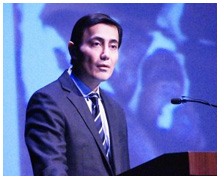
By: Kent Spencer
Regarded as one of the top plastic surgeons in Chicago, assistant professor of surgery at Northwestern, Dr. Robert D. Galiano gave an hour-long lecture in the Dorothy Menker Theater on the evening of February 8.
In front of a crowd of over 100 people, Galiano shared information about scarring and gave new insights of the breakthroughs in the field of plastic surgery.
Galiano also shared what was new in the field of plastic surgery and cosmetic surgery. Through his years as a doctor, his favorite procedure to preform is breast reduction, which relieves woman of back and neck strain. With this, he explained that there are over 25 techniques of breast reduction.
“Keloids have been a major branching of the unwanted result of scarring,” explained Galiano. A keloid grows beyond the boundary of scars and has many different treatments such as excisions, steroids, radiation, and the usage of chemotherapeutic agent’s 5-FU and Bleomyein. There are surprising factors within who gets scars. Race and age are factors people often don’t know about. African Americans and Asians are at a higher risk among all races to get keloids. Ages between 10-30 are also at highest risk for developing keloids. Doctors have found that properly closing incisions helps reduce this occurrence.
Big or small, scars rank at the top of people’s personal list for undesirable features. People spend hundreds of dollars on creams and procedures to help remove childhood scars. Making sure the scar is moisturized is a major step in decreasing its visibility. Using moisturizers such as baby oil can have a great effect. Galiano explained that silicon gel sheets are becoming popular in the plastic surgery world for reducing scars.
Galiano also highlighted some tips for skin care. He said to get sleep, to not smoke, and to not stay under the sun too much. He pointed out cosmetology is thriving with great treatments to help wrinkles using Botox and Dysport. Galiano included there are currently great options for looking younger. The deep plane facelift is becoming a very usable option to be a great feature for a great natural facial look.
Galiano did a great job explaining what’s new in the medical field. Even with no plans of any of these procedures, it’s important to know what’s available and progress of health improvement.

